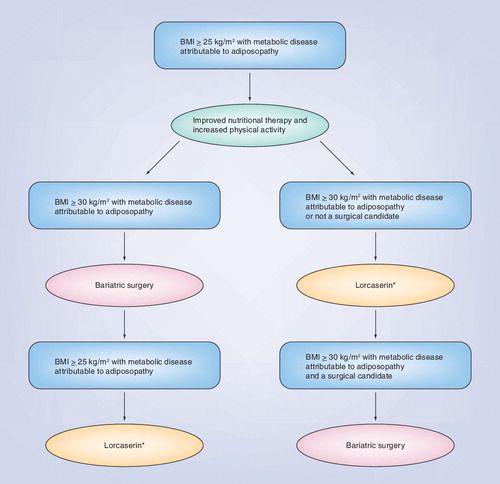Figures & data
Increased CNS serotonin, leptin and/or insulin activity increases anorexigenic POMC (which is cleaved to form melanocortins such as MSH) and CART expression, and decreases orexigenic expression of NPY and AgRP. Alterations in these peptidergic appetitive effectors contribute to ‘second order’ signaling through arcuate nucleus neurons projection to other hypothalamic regions. The net result of increased CNS serotonergic activity is increased anorexigenic and increased catabolic effects, with decreased orexigenic and decreased anabolic effects. This figure is greatly simplified, and does not show all the interconnected signaling pathways between these CNS factors.
AgRP: Agouti-related peptide; BDNF: Brain-derived neurotrophic factor; CART: Cocaine amphetamine-regulated transcript; CB1: Cannabinoid 1 receptor; CRH: Corticotropin-releasing hormone; MC3R: Melanocortin 3 receptor; MC4R: Melanocortin 4 receptor; MCH: Melanin concentrating hormone; MSH: Melanocyte stimulating hormone; NPY: Neuropeptide Y; POMC: Pro-opiomelanocortin; TRH: Thyroid releasing hormone.
![Figure 1. Simplified relationship between serotonin (and other selected CNS factors) on anorexigenic and orexigenic peptidergic appetitive effectors within the hypothalamus Citation[36,112].Increased CNS serotonin, leptin and/or insulin activity increases anorexigenic POMC (which is cleaved to form melanocortins such as MSH) and CART expression, and decreases orexigenic expression of NPY and AgRP. Alterations in these peptidergic appetitive effectors contribute to ‘second order’ signaling through arcuate nucleus neurons projection to other hypothalamic regions. The net result of increased CNS serotonergic activity is increased anorexigenic and increased catabolic effects, with decreased orexigenic and decreased anabolic effects. This figure is greatly simplified, and does not show all the interconnected signaling pathways between these CNS factors.AgRP: Agouti-related peptide; BDNF: Brain-derived neurotrophic factor; CART: Cocaine amphetamine-regulated transcript; CB1: Cannabinoid 1 receptor; CRH: Corticotropin-releasing hormone; MC3R: Melanocortin 3 receptor; MC4R: Melanocortin 4 receptor; MCH: Melanin concentrating hormone; MSH: Melanocyte stimulating hormone; NPY: Neuropeptide Y; POMC: Pro-opiomelanocortin; TRH: Thyroid releasing hormone.](/cms/asset/469b8346-307f-40c3-9cbf-7677a414489b/ierk_a_11210497_f0001_b.jpg)
*‘Lorcaserin’ is listed as an illustrative example of an anti-obesity agent that alone, or possibly in combination with other anti-obesity agents, may improve adiposopathy. The intent is to improve the otherwise dysfunctional adipose tissue in overweight patient, and thus correct the pathogenic endocrine and immune derangements that lead to metabolic disease.
